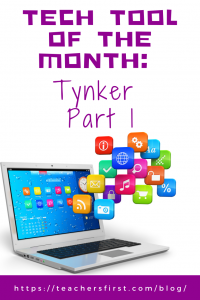Tynker is an engaging tool for students to use to learn the basics of coding. The tool is available as a website or mobile app, and while the features differ slightly between the two versions, they both offer a powerful coding tool with curriculum lessons and activities. The app version offers Tynker Junior, designed for kids ages 5–7. Tynker is user-friendly, with free programs available for teachers, parents, and students (additional options are available at a cost). The free portion of the educator site includes three coding courses, interactive games, blog posts and articles, an art studio, lessons and activities related to the Hour of Code, and more.
Applying the Triple E Framework
The Triple E Framework, created by Dr. Liz Kolb, is built on the belief that “effective technology integration begins with good instructional strategies and not fancy tools” (tripleeframework.com). Dr. Kolb wrote a book on the topic, Learning First, Technology Second (ISTE, 2017), that lays out the three main uses for technology in education: to Engage, Enhance, or Extend learning goals. We can use this framework to decipher why we are using specific tools in the classroom. Here is a rubric based on the Triple E Framework you can use to evaluate whether Tynker (or any other technology) is a good fit with your learning goals and whether you should use Tynker in your lesson.

- Engage in learning goals: When using Tynker, students are more focused on the task because they are engaged in coding activities. Students are active learners as they work through the immersive coding courses, rather than passively reading the content or instructions. The learning modules/courses offer built-in tutorials, how-to videos, and even competition to keep students’ interest and motivate them to become more independent learners.
- Enhance learning goals: This tool enhances learning goals by scaffolding the coding instructions step-by-step, which allows students to progress at their own pace. Students are able to demonstrate a more sophisticated understanding of coding using these courses. Tynker allows students to use technology to deepen their understanding of concepts and coding. Activities are not isolated in workbooks or stand-alone—they are connected and weaved throughout the lessons. The built-in tutorials and how-to videos help enhance remote learning lessons. Students use higher-order thinking skills, creativity, perseverance, and the engineering design process as they create their codes, test out their ideas, and take the steps required to arrive at their final product. If you aren’t familiar with the engineering design process, check out this simple descriptive video and share it with your students as they begin coding and using the process.
- Extend learning goals: Dr. Kolb describes extended learning as an opportunity for students to learn, connect, and collaborate outside of the regular school day and as a bridge between the school day and real-life experiences. The activities in Tynker would fit in with flipped, blended, and remote learning lessons. The built-in tutorials and how-to videos can help to extend learning outside of the classroom during remote learning. Tynker activities help to prepare students for learning beyond the classroom, as they will likely need to use digital tools and follow a designed plan (and possibly even know coding) in their future employment, education, and personal life.
SAMR Connection
The SAMR Model, by Dr. Ruben Puentedura, suggests that technology implementation has four levels. We can use this model as a guideline to analyze how we’re using technology tools in the classroom. Tynker is at the level of Redefinition.
- Redefinition: At the highest level of SAMR, technology allows for the creation of new tasks that were not possible before. Tynker allows students to learn how to program and code using a computer—without technology, this would not be possible. The technology for Tynker offers student-centered learning. If you would like to take the Tynker activities a step further and offer collaboration, students can post a link to their finished coding projects on Padlet (reviewed here). Padlet also has a commenting feature, so students can easily share feedback with their peers.
Don’t miss Part 2 of the Tech Tool of the Month: Tynker, where we’ll discuss how to use the tool and introduce ways to use it in the classroom. In the meantime, let us know in the comment section below how you have used Tynker in your education setting.


One thought on “Tech Tool of the Month: Tynker (Part 1)”